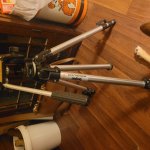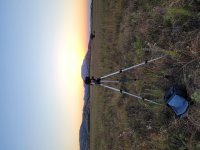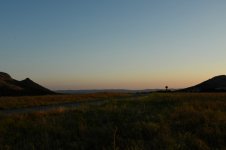I agree with Doc - but would add... Of course you want to get the best bang for your buck, but at the same time, a good tripod is one area where you don't want to go cheap (inexpensive doesn't necessarily mean "cheap" as in the used Bogen or Manfrotto tripods that Doc mentioned).
Another thing to consider is why and when you might "need" a tripod in the first place. With the capabilities of todays digital cameras, the paradigm has shifted a bit. In the old days, cameras did not have things like In Body Image Stabilization (IBIS) and lenses didn't have optical IS (or they had very crude IS). I forgot what camera you have and what lenses, but if your camera has IBIS or even if your lenses have IS, then the situations where you really need a tripod are going to be less. Also, if you are shooting at shutter speeds sufficiently high, even if you don't have IS, then the need for a tripod is lessened. Generally (crude rule of thumb), if you don't have any IS, but your shutter speeds are at 1/[focal length] or faster, you can get acceptably sharp shots hand-held. So, for example, if you are shooting with a 200mm tele lens, then you can usually get by without a tripod if you are shooting at shutter speeds of 1/200 or faster. So, shooting at 1/250th you should be fine hand held (of course you want to observe good camera shooting techniques, elbows in hold breath when you shoot. Press, don't PUSH the shutter, etc). Wider angle lenses are even less susceptible to camera-induced motion blur, so shooting with a 50mm for example, you could get away with 1/60th sec hand-held.
For me, since my camera has IBIS and most of my lenses have IS, I have gotten to the point where my use cases for using a tripod are much less that they used to be. Usually, I'll just shoot hand held
unless the lighting is such that I need to shoot at much slower shutter speeds (like dawn or dusk). Of course the longer the lens, the more a tripod will help since any camera motion is amplified at longer focal lengths. With my R5 and an RF lens, I can get up to 8 stops of image stabilization (they claim). What this means in practical terms, is I can bust that 1/[focal length] rule and still get sharp images. Theoretically, if I was shooting at 200mm, I'd want to shoot at 1/250th or faster. BUT, with 8 stops of IS, I could (again theoretically) shoot 8 stops slower. In reality I don't try to push things that far. I might feel comfortable at maybe 3 stops slower (1/30th). The longer the lens, the more I try to stay close to the rule. One reason I will sometimes use a tripod, even if I'm not worried about image blur, is when I want to take my time composing a scene. When you are using a tripod, you can take your time framing up the image to get it "just right" before you fire the shot. PS: I usually either use a remote trigger or set the camera for a 2 second timer so as not to introduce camera shake from pushing the shutter button. I often use a tripod when I'm shooting birds with a very large lens, just to make it easier on my spindly arms. In this case I use a gimbal head. Of course I always use a tripod when I'm shooting night she scenes.
Of course stability is the main thing you are looking for in a tripod, but other facts should be considered as well:
Weight
rating: Are you going to be using the tripod with very large camera / lenses? Look at the weight of your camera and the biggest lens you anticipate using and make sure the tripod and ball head are rated well above that (head is as important as the tripod, maybe more so).
Portability, ease of carry: The kind of tripod you might want in a studio setting is going to be different than what you would want if you plan to carry it on hikes, for example. I know you said you didn't see the need for carbon fiber, but IF you intend to do any hiking with the tripod, then carbon fibre is worth considering - it is very strong and much lighter than aluminum. Just some food for thought, but if I were looking at tripods and could get a decent CF tripod that I could afford, that's what I'd do. Nothing wrong with aluminum, but they just are not going to be as easy to carry.
Height: Many tripods today have a center column that will raise the camera higher. Personally, I prefer a tripod that is high enough for me to use it comfortably (not needing to stoop down too much) without needing to raise the center column. Raising the center column, in most cases, reduces the over all stability of the camera, so getting a tripod that will all the camera to be high enough for YOU without the center column is something to at least consider.
There are a ton of videos on You Tube about what to look for in a tripod (and just as important, a head). Here is one I find pretty good by a guy I follow on YT, Matt Granger,
Lastly: The Manfrottos and Bogen, Gitzo, Really Right Stuff, etc., are all really good quality tripods, and you can get good used copies for "reasonable" money. Also, one you might want to look at that is much less expensive than those (new), is the Sirui brand. B&H and Adorama and most of the big box photo stores sell them. I have a Sirui Carbon Fiber tripod that I absolutely love. It's light, compact and very sturdy. I also have a very compact, light weight Heipi tripod that I use mainly for hiking and when I'm using lighter gear.
Choosing a good tripod to fit your needs can seem a daunting task because there are so many things to consider. Hopefully the video above will help you determine what you need for your particular shooting use cases. Good luck.

 Hi Guest!
Hi Guest!

 smilie in place of the real @
smilie in place of the real @
 Pretty Please - add it to our Events forum(s) and add to the calendar! >>
Pretty Please - add it to our Events forum(s) and add to the calendar! >> 







